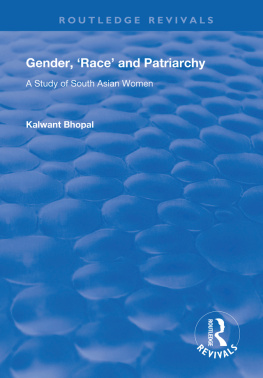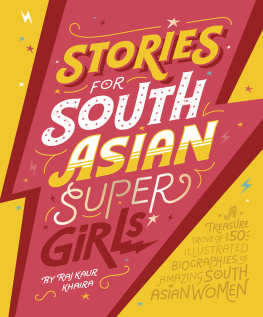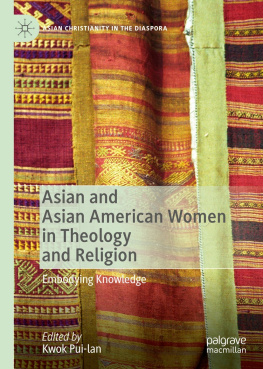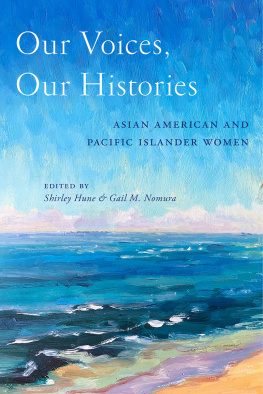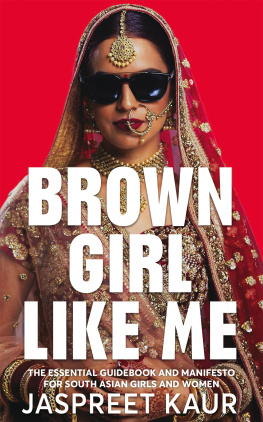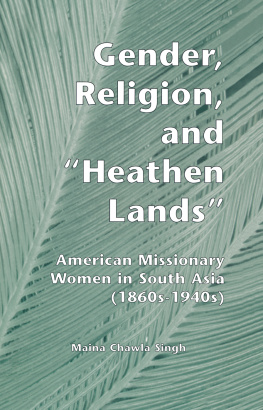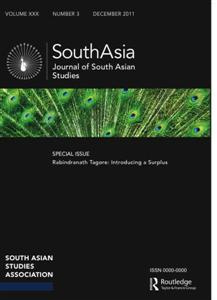First published 1997 by Ashgate Publishing
Reissued 2018 by Routledge
2 Park Square, Milton Park, Abingdon, Oxon, OX14 4RN
711 Third Avenue, New York, NY 10017, USA
Routledge is an imprint of the Taylor & Francis Group, an informa business
Copyright K. Bhopal 1997
All rights reserved. No part of this book may be reprinted or reproduced or utilised in any form or by any electronic, mechanical, or other means, now known or hereafter invented, including photocopying and recording, or in any information storage or retrieval system, without permission in writing from the publishers.
Notice:
Product or corporate names may be trademarks or registered trademarks, and are used only for identification and explanation without intent to infringe.
Publisher's Note
The publisher has gone to great lengths to ensure the quality of this reprint but points out that some imperfections in the original copies may be apparent.
Disclaimer
The publisher has made every effort to trace copyright holders and welcomes correspondence from those they have been unable to contact.
Typesetting by Bad Seed Productions, London
ISBN 13: 978-1-138-31544-0 (hbk)
ISBN 13: 978-0-429-45630-5 (ebk)
Feminism and race
Gender and feminism have emerged as important areas of study which have attempted to explain the position of women in society; the limited access of women to economic, social and political power, the nature of the sexual division of labour and those social expectations about the behaviour of women which limit and inhibit their achievements. This has raised the problem of how equality for women is to be achieved, or in feminist terms how the subordination of women is to be ended. Many feminists have attempted to understand, analyse and explain the subordination of women (Barrett 1980, Millett 1977, Mitchell 1971). These feminists have attacked traditional social theory for excluding and marginalising women and have specifically investigated women in order to include their experiences and render them legitimate. There is a growing body of literature on gender which examines women's position within households and families (Finch 1983, 1989, Oakley 1974) women and education (Deem 1978), women's exclusion and segregation from the labour market (Hakim 1979, Walby 1986), women and politics (Currell 1974, Kirkpatrick 1974), sexuality (Dworkin 1981, Mackinnon 1979) and violence (Brownmiller 1976, Pizzey 1974).
However, feminism has always been vulnerable to the accusation that its concerns and priorities reflect those of white, middle class women and conceal the variety and diversity of human experience and subjectivity. Some black feminists (Collins 1990, Davis 1990), are now demanding that the experiences of women who have hitherto been marginalised become a central starting point rather than an optional extra for feminist theory and practice.
Some writers are also beginning to acknowledge their own limitations (Barret and Macintosh 1985). Ramazanoglu (1986) argues that the problem is not simply one of acknowledging that differences exist between black, third world and white women, but challenging the underlying assumptions that white women are the norm and that the experiences of black and third world women are some kind of 'alien' problem. This assumption not only denies the validity and primacy of these 'other' experiences, but can often lead to simplistic generalisations with regard to all women. It can also deny the pain of racism in which white feminists can be the beneficiaries and perpetuators of the racism that many black women see as the primary experience of their lives.
For other writers, the solution is to develop a specifically black feminist approach based on black women's own experiences which sees racism as the central issue (Joseph 1981). However, the problem remains, just as the term 'man' marginalised women and the term 'women' marginalised 'non-white' women, so too the term 'black women' can marginalise some groups and ignore the vast economic and cultural differences amongst those the term supposedly encompasses. It can also ignore the class divisions and racism that may exist within and between 'black groups'. Nevertheless, the whole feminist project does insist that the category 'woman' is a meaningful one and a critical awareness of the problems involved in the use of such terms as 'white women' or 'black women' need not invalidate a use of the terms themselves or a political action based upon them. On a global scale, this means that the differences between women cannot be understood outside the context of colonialism, imperialism and nationalistic struggles for independence.
Other feminists (Davis 1990, King 1988) insist, not only that issues of class, sex and 'race' are inherently connected, but that a black feminist perspective is the most truly radical because:
...the necessity of addressing all forms of oppression is one of the hallmarks of black feminist thought (King 1988:43).
The idea of sisterhood which implies an oppression shared by all women, gives way to that of solidarity which is based upon an understanding that the struggles of all women are different, but interconnected. Gender divisions are not the only source of social inequality, for many women 'race' or class may be more important. This means simplistic assertions of the universality of women's experience are incorrect. These may deny the very real differences that exist amongst women and, by invoking a spurious sisterhood that takes white middle class women as the norm, can constitute a form of racism and elitism.
Rather than engaging in a sterile debate as to which is the most important, feminism can develop an analysis that recognises the interaction of different forms of oppression and does not treat women as a unitary category that can be abstracted from all other social relationships. Such an approach allows scope for solidarity to encourage a worldwide feminism based on the understanding that on a global scale, there are both underlying patterns of gender inequality and an enormous diversity of needs and experiences that divide as well as unite women. It is not simply a case of 'adding on' the perspectives of black women, but may involve a reassessment of understanding as a basis of that which feminism demands of male-stream theory
The black female constituency as an object of political analysis is demarcated by the experience of 'race' and gender oppression. The response of feminists such as Bhavnani and Coulson (1986), Carby (1982) and Parmar (1982), has been to establish the specificity of black women and their experiences. A black female constituency is further demarcated in many black feminist accounts by the experience of oppression (Carby 1982, Parmar 1982). It is this, which it is suggested, unites black women and places them in opposition to white women. The experiences of which black women speak, arise from being both black and female in a white society which may be racist. Oppression is organised around 'race' and gender divisions, with racial divisions being accorded a primacy in the establishment of political priorities. Racial oppression is presented as the result of forms of interaction between black women and black men, British society and a range of British social institutions in particular. Racial oppression is something which black women share with black men. Racial disadvantage and racism can be viewed in terms of practices, procedures and actions which have the effect of excluding, providing unequal access, or in some way disadvantaging black people.

